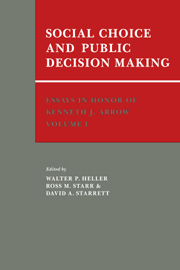PART I - SOCIAL CHOICE
Published online by Cambridge University Press: 05 November 2011
Summary
Arrow is the creator of the field of social choice. Naturally, there were precursors, but the leap from previous literature to Social choice and individual values (1951) was as great as any in the postwar period in economics. Arrow showed that it was impossible to find a reasonable and consistent procedure for any society to choose among conflicting alternatives. The basic properties a procedure had to satisfy to be “reasonable” were these: that all rankings (including the social ranking) be transitive, that any preferences are possible (universal domain); that the social ordering put alternative a ahead of alternative b if everybody prefers a to b (Pareto principle); that, in choosing between two alternatives, society only need consult people's preferences over those two alternatives (independence of irrelevant alternatives), and finally, that no person is a dictator.
All literature that followed had to grapple with, in some way, the basic facts behind Arrow's theorem. Indeed, much of the subsequent literature is devoted to weakening one or more of Arrow's conditions in attempting to escape from the impossibility theorem.
Hammond reexamines two attempts to escape from Arrow impossibility from the viewpoint of “consequentialism,” that is, all decisions should be based solely on their feasible consequences. He finds that relaxation of either the independence of irrelevant alternatives or the ordinality of the social choice function violates consequentialism.
- Type
- Chapter
- Information
- Essays in Honor of Kenneth J. Arrow , pp. 1 - 2Publisher: Cambridge University PressPrint publication year: 1986



